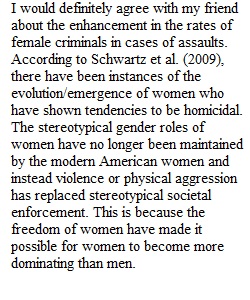


Q Paper Topic 1 – Crime Data, Patterns, and Trends Seminar in Criminology – CJ7020 (Feldmeyer) Instructions: Please pick 1 of the following questions about data and patterns/trends in crime, and write a response to the question. Make sure to answer all parts of the question. Your response should be based on the evidence and findings from lecture and reading. Your response should be 3-4 pages in length, double spaced (times new roman, 12pt font, 1 inch margins). Your paper is DUE 1-20-19 (Sunday) by Midnight (your time zone). ______________________________________________________________________________ Choice 1: A friend of yours tells you that they just heard on the news that women are “catching up” to male levels of arrests for crimes like assault. Your friend then says, “I didn’t realize women have become so much more criminal in recent years. Times sure have changed. They are becoming just as violent and dangerous as men!” Based on the material and reading from this module, how would you respond to your friend’s statement? What does women’s crime look like and what has been happening to gender patterns in crime over time? Make sure to describe the evidence from research and the findings on women’s patterns and trends in crime across different types of crime data (arrest, victimization, etc.) and across different offense categories. Choice 2: UCR arrest data and other official sources of crime data have often been criticized because they are thought to present a biased picture of race patterns in crime. Is this a valid critique? In your response, make sure to address the following: a. What are the race patterns in crime that we see in UCR arrest data, and what are the potential problems with using arrest data to measure race patterns in crime? b. Victimization and self-report surveys have often been used as an alternative way of identifying race differences in crime. What are their strengths/limitations for assessing race and crime compared to the UCR, and what do race-crime patterns look like in these data compared to the UCR? c. In sum, can we reach any consensus or clear conclusions about race and crime in the U.S., and given the different limitations of each data source, do you think researchers should value one of these types of data over others for studying race and crime? Choice 1
View Related Questions